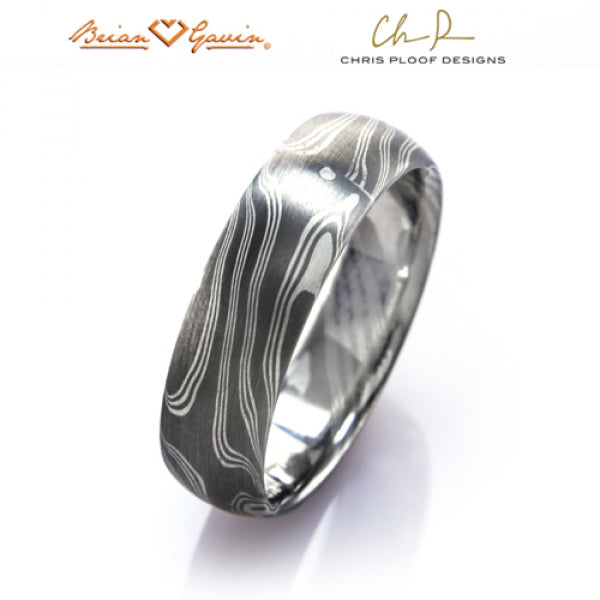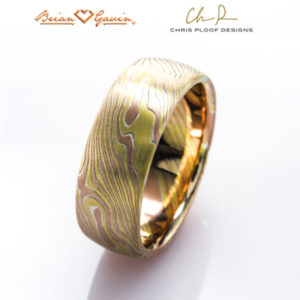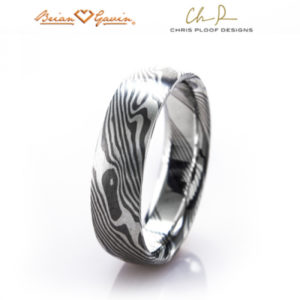
Buyers Guide: Mokume Gane Rings and Wedding Bands
So, what is Mokume Gane?
At first glance, most people think that Mokume Gane reminds them of woodgrain. That’s not surprising, since the Japanese words Mokume Gane, translates as woodgrain metal. In fact, the technique was developed in Japanese sword makers in feudal Japan.
The technique of making samurai swords using Mokume Gane was developed several hundred years after the creation of Damascus steel. It was used to adorn samurai swords with decorative patterns, thereby making each sword even more special and unique.
Today, there are very few people who still know how to create the woodgrain effect of Mokume Gane. Which is one of the reasons why Brian Gavin is proud to announce that Mokume Gane rings and wedding bands by Chris Ploof are now available.
How is Mokume Gane Made?
 The woodgrain metal effect of Mokume Gane is created by forging layers of different metals together using high heat and pressure. This process fuses the metals together into one solid block, which is then manipulated further by forging, twisting, and carving the metal, to expose the different layers.
The woodgrain metal effect of Mokume Gane is created by forging layers of different metals together using high heat and pressure. This process fuses the metals together into one solid block, which is then manipulated further by forging, twisting, and carving the metal, to expose the different layers.
The process of doing so, unveils the beautiful woodgrain-like patterns that formed as the different metals were fused together. Obviously, the woodgrain patterns are going to be as unique and different, as they are with each piece of wood. Layer by layer, the beauty is revealed.
In this manner, every Mokume Gane ring and wedding band handcrafted by Chis Ploof represents a unique piece of art. It’s not possible for any two rings to be exactly the same. Thus, your Mokume Gaine ring and wedding band, will truly be as unique and special as you are.
A perfect blend of two individual metals, coming together to create a unique bond like no other. Of course, many different combinations of metal can be intertwined in the art of Mokume Gane. Part of the magic is knowing which metals to combine to create just the right effect.
What alloys are used in Mokume Gane?
As you can imagine, creating the stunning effects of Mokume Gane is not as simple as merely mashing two metals together and hoping for the best. If it were that simple, there would be more than a handful of people who are capable of creating this stunning effect!
The artisan making Mokume Gane must possess a thorough understanding of the individual properties of the metals being used, as well as being familiar with the different melting temperatures. That may seem simple enough on the surface, but it’s knowing how to get the metals to blend together seamlessly that is the trick.
Get the metals too hot and they just blend together, keep them too cool and they’ll never bond. Hmmm, this is beginning to sound a bit like relationship advice, perhaps there is a correlation. Perhaps you’ll contemplate this fact from time to time while wearing your Mokume Gane band through the course of your lifetime.
Mokume Gane rings and bands are made from:
- 18k yellow gold and silver
- 14k red gold and silver
- 14k palladium white gold and silver
- 18k yellow gold, 14k palladium white gold and thin layers of silver
- 18k yellow gold and 14k red gold and thin layers of silver
- 14k red gold and 14k palladium white gold and thin layers of silver
- 18k yellow and 18k green gold and thin layers of silver
- 22k yellow gold and Gibeon Meteorite
- Palladium 950 and silver
- Palladium 950 and 14k palladium white gold
Is Mokume Gane available with copper?
Chis Ploof does not user copper in the creation of Mokume Gane rings and bands. The reason is because some people have a reaction to copper. Other people might have slightly acidic sweat, which can literally etch the copper right out of their ring.
Regardless of whether you have a reaction to copper or not, it’s not a good idea to wear copper that is combined with other metals in this fashion. Apparently, when combined with other metals, copper can create a galvanic cell. That’s a type of weak, natural battery effect, which will cause the copper to deteriorate in as short as one year’s time. This is why traditional Mokume Gane artisans to not incorporate copper in their designs.
 The Wearable Art of Mokume Gane:
The Wearable Art of Mokume Gane:
Mokume Gane rings and bands are created in the traditional manner. Straight pieces of metal are patterned, then bent into a circle and fused together. The metal is then worked by being twisted, cut, reformed, ground down and shaped with chisels and punches. Then it is rolled out into sections of workable metal in thickness appropriate for making rings and bands.
It is at this point, that the Mokume Gane patterns become self-evident. And this is where the fun really begins, because it’s at this point where you get to start exploring the intricate nature and personality of your Mokume Gane ring or wedding band. You can literally spend hours studying and becoming familiar with the unique pattern of Mokume Gane exhibited by your ring.




















